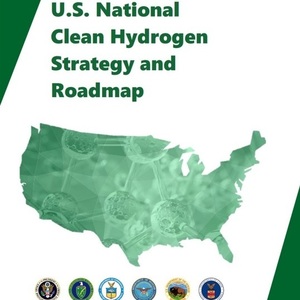DOE releases US National Clean Hydrogen Strategy and Roadmap

June 6, 2023
BY Erin Krueger
The U.S. Department of Energy on June 5 released its first ever U.S. National Clean Hydrogen Strategy and Roadmap, which addresses both the potential to produce hydrogen from biomass and biogas and the growing need for hydrogen feedstock in the advanced biofuels industry, particularly for the production of sustainable aviation fuel (SAF) and power-to-liquid fuels.
The U.S. National Clean Hydrogen Strategy and Roadmap is a comprehensive framework for accelerating the production, processing, delivery, storage and use of clean hydrogen. According to the DOE, achieving commercial-scale hydrogen deployment is a key component of building a strong clean energy economy and enabling long-term decarbonization objectives. It will also help create jobs, with current estimates indicating that America’s growing hydrogen economy has the potential to add 100,000 net new direct and indirect jobs by 2030.
“Accelerating the deployment of hydrogen is key to achieving President Biden’s vision for an affordable, secure clean energy future,” said U.S. Secretary of Energy Jennifer M. Granholm. “That’s why DOE worked alongside our federal partners to develop the U.S. National Clean Hydrogen Strategy and Roadmap that will lay the foundation for a strong and productive partnership between the public and private sectors and will guide government and industry to realize the full potential of this incredibly versatile energy resource.”
Advertisement
The roadmap identifies three key strategies to ensure that clean hydrogen is developed and adopted as an effective decarbonization tool, including targeting strategic, high-impact uses for clean hydrogen; reducing the cost of clean hydrogen; and focusing on regional networks.
Within the report, the DOE identifies several potential pathways to hydrogen production, including via biomass gasification with carbon capture and storage (CCS) and steam methane reforming (SMR) or autothermal reforming (ATR) using feedstocks such as biogas from organic landfill matter, sewage, or agricultural wastes in place of natural gas. According to the DOE, these production methods have the potential to be low-carbon or carbon-negative depending on the feedstock. The agency also notes that lifecycle emissions across the entire biomass supply chain, including direct and indirect land use changes and agricultural inputs, such as fertilizer, should be considered when evaluating these pathways.
When biomass production pathways are coupled with CCS, their net emissions have the potential to be negative, according to the DOE. For example, when waste feedstock is diverted from landfills and instead used to make hydrogen, some of the methane generated by processing the waste is also diverted from the atmosphere and thermally converted to clean hydrogen. This includes methane that would not otherwise have been flared, given regional best practices and regulations, the DOE explained.
Advertisement
The bioenergy sector is not only a potential supplier of hydrogen—it is also a consumer of hydrogen feedstock. Hydrogen is an essential feedstock in the production of some kinds of biofuels, including SAF. The DOE estimates that if the U.S. replaces all jet fuel consumption with SAF by 2050, approximately 2-6 million metric tons per year (MMT/year) of hydrogen could be required to produce 35 billion gallons of SAF from biofuels. An additional 6 MMT/year would be required to produce 4 billion gallons of power-to-liquid fuels using 44 MMT of carbon dioxide, which equates to approximately the amount of concentrated carbon dioxide currently available from ethanol plants in the U.S., according to the DOE.
A full copy of the report is available on the DOE website.
Related Stories
Calumet Inc. on Aug. 8 confirmed its Montana Renewables biorefinery is currently running at full capacity. An initial phase of the company’s MaxSAF initiative remains on track to boost SAF capacity to up to 150 MMgy by mid-2026.
The USDA maintained its outlook for 2025-’26 soybean oil use in biofuel production in its latest World Agricultural Supply and Demand Estimates report, released Aug. 12. The forecast for soybean oil prices was also unchanged.
U.S. soybean production for 2025 is forecast at 4.29 billion bushels, down 2% when compared to last year, according to the USDA National Agricultural Statistics Service’s latest monthly Crop Production report, released Aug. 12.
Marathon Petroleum Corp. on Aug. 5 released second quarter financial results, reporting improved EBITDA for its renewable diesel segment. The company primarily attributed the improvement to increased utilization and higher margins.
Chevron Corp. on Aug. 1 confirmed the company started production at the Geismar renewable diesel plant in Louisiana during the second quarter after completing work to expand plant capacity from 7,000 to 22,000 barrels per day.
Upcoming Events










